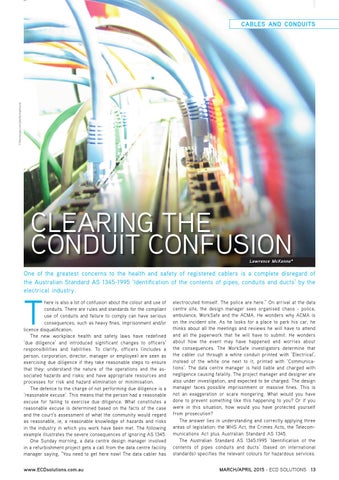© freeimages.com/profile/martwork
CABLES AND CONDUITS
CLEARING THE CONDUIT CONFUSION
Lawrence McKenna*
One of the greatest concerns to the health and safety of registered cablers is a complete disregard of the Australian Standard AS 1345-1995 ‘Identification of the contents of pipes, conduits and ducts’ by the electrical industry.
T
here is also a lot of confusion about the colour and use of conduits. There are rules and standards for the compliant use of conduits and failure to comply can have serious consequences, such as heavy fines, imprisonment and/or licence disqualification. The new workplace health and safety laws have redefined ‘due diligence’ and introduced significant changes to officers’ responsibilities and liabilities. To clarify, officers (includes a person, corporation, director, manager or employee) are seen as exercising due diligence if they take reasonable steps to ensure that they: understand the nature of the operations and the associated hazards and risks; and have appropriate resources and processes for risk and hazard elimination or minimisation. The defence to the charge of not performing due diligence is a ‘reasonable excuse’. This means that the person had a reasonable excuse for failing to exercise due diligence. What constitutes a reasonable excuse is determined based on the facts of the case and the court’s assessment of what the community would regard as reasonable, ie, a reasonable knowledge of hazards and risks in the industry in which you work have been met. The following example illustrates the severe consequences of ignoring AS 1345. One Sunday morning, a data centre design manager involved in a refurbishment project gets a call from the data centre facility manager saying, “You need to get here now! The data cabler has
www.ECDsolutions.com.au
electrocuted himself. The police are here.” On arrival at the data centre site, the design manager sees organised chaos - police, ambulance, WorkSafe and the ACMA. He wonders why ACMA is on the incident site. As he looks for a place to park his car, he thinks about all the meetings and reviews he will have to attend and all the paperwork that he will have to submit. He wonders about how the event may have happened and worries about the consequences. The WorkSafe investigators determine that the cabler cut through a white conduit printed with ‘Electrical’, instead of the white one next to it, printed with ‘Communications’. The data centre manager is held liable and charged with negligence causing fatality. The project manager and designer are also under investigation, and expected to be charged. The design manager faces possible imprisonment or massive fines. This is not an exaggeration or scare mongering. What would you have done to prevent something like this happening to you? Or if you were in this situation, how would you have protected yourself from prosecution? The answer lies in understanding and correctly applying three areas of legislation: the WHS Act, the Crimes Acts, the Telecommunications Act plus Australian Standard AS 1345. The Australian Standard AS 1345:1995 ‘Identification of the contents of pipes conduits and ducts’ (based on international standards) specifies the relevant colours for hazardous services.
MARCH/APRIL 2015 - ECD SOLUTIONS 13
